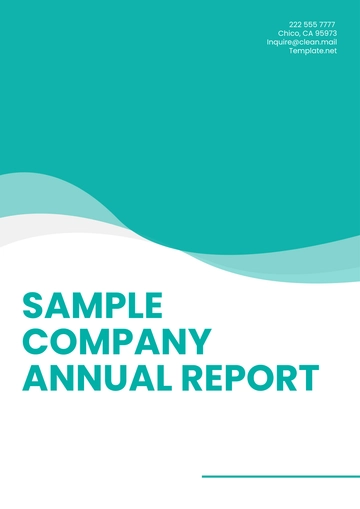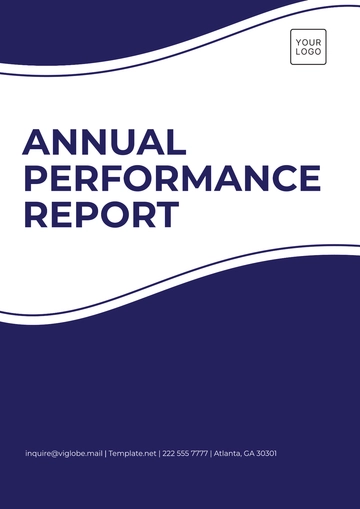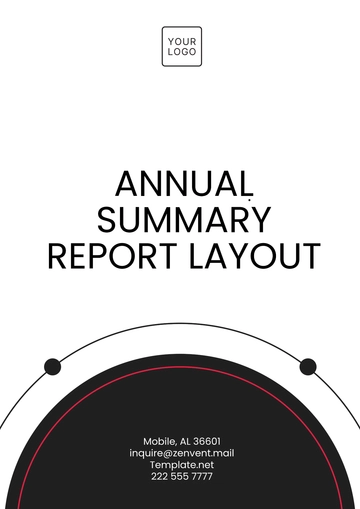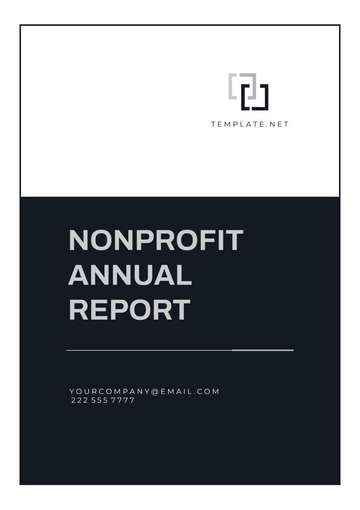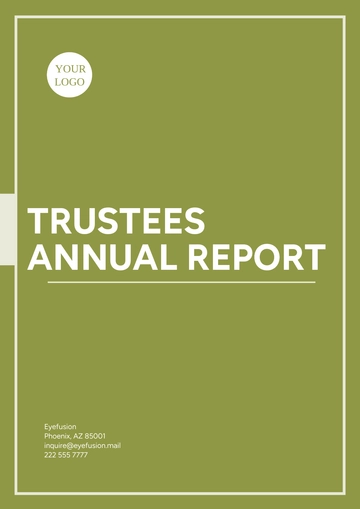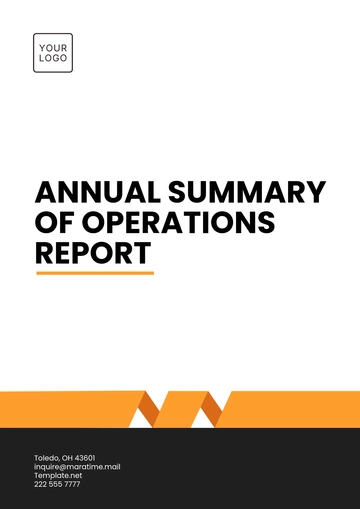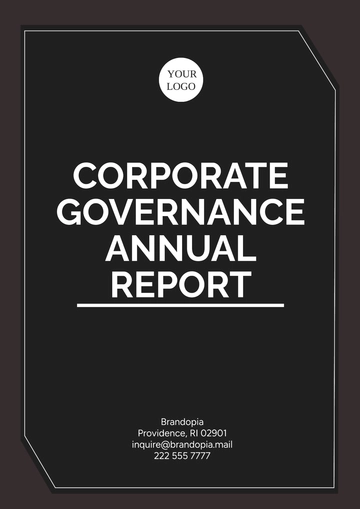Free Year-End Sales Review Report
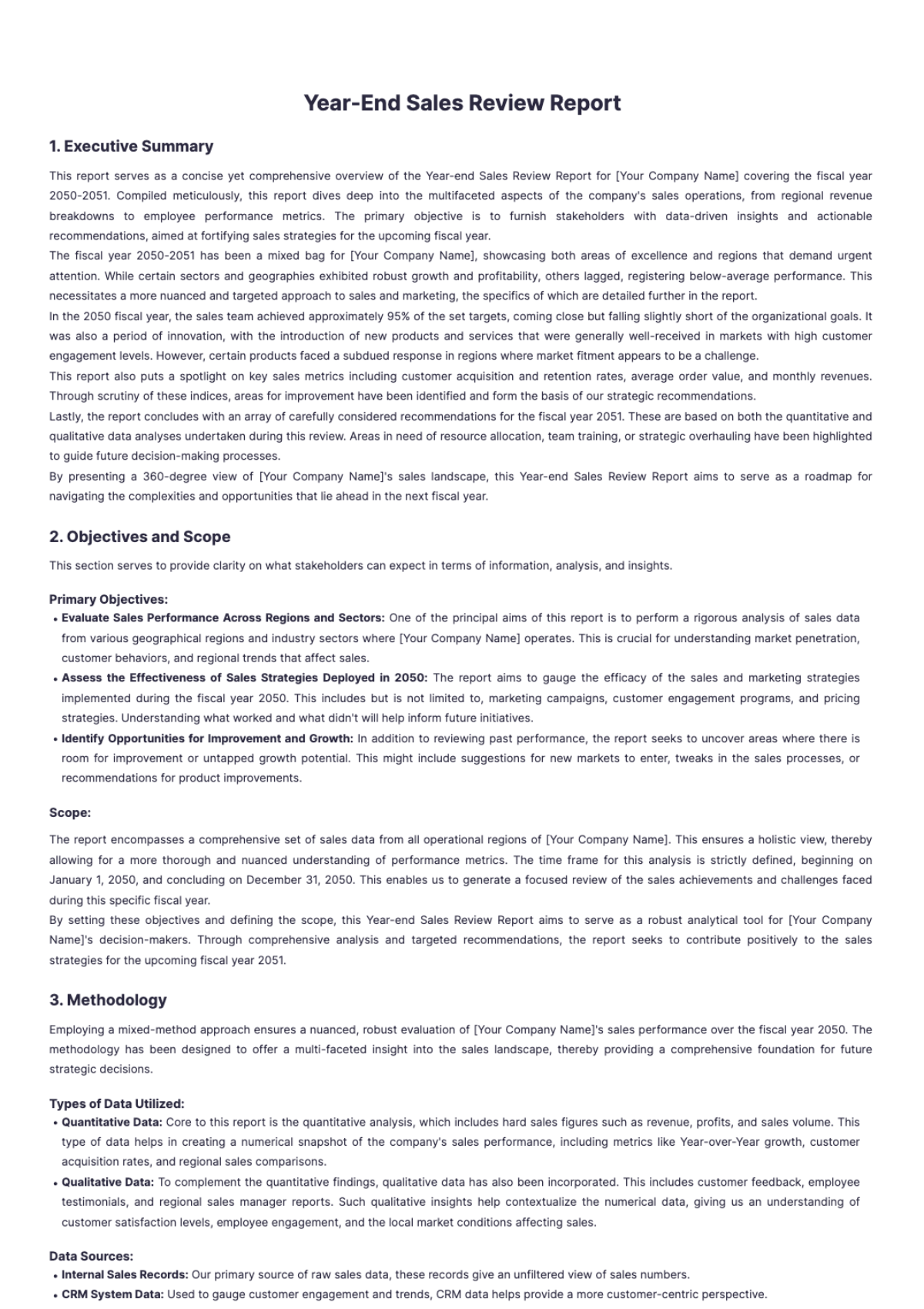
1. Executive Summary
This report serves as a concise yet comprehensive overview of the Year-end Sales Review Report for [Your Company Name] covering the fiscal year 2050-2051. Compiled meticulously, this report dives deep into the multifaceted aspects of the company's sales operations, from regional revenue breakdowns to employee performance metrics. The primary objective is to furnish stakeholders with data-driven insights and actionable recommendations, aimed at fortifying sales strategies for the upcoming fiscal year.
The fiscal year 2050-2051 has been a mixed bag for [Your Company Name], showcasing both areas of excellence and regions that demand urgent attention. While certain sectors and geographies exhibited robust growth and profitability, others lagged, registering below-average performance. This necessitates a more nuanced and targeted approach to sales and marketing, the specifics of which are detailed further in the report.
In the 2050 fiscal year, the sales team achieved approximately 95% of the set targets, coming close but falling slightly short of the organizational goals. It was also a period of innovation, with the introduction of new products and services that were generally well-received in markets with high customer engagement levels. However, certain products faced a subdued response in regions where market fitment appears to be a challenge.
This report also puts a spotlight on key sales metrics including customer acquisition and retention rates, average order value, and monthly revenues. Through scrutiny of these indices, areas for improvement have been identified and form the basis of our strategic recommendations.
Lastly, the report concludes with an array of carefully considered recommendations for the fiscal year 2051. These are based on both the quantitative and qualitative data analyses undertaken during this review. Areas in need of resource allocation, team training, or strategic overhauling have been highlighted to guide future decision-making processes.
By presenting a 360-degree view of [Your Company Name]'s sales landscape, this Year-end Sales Review Report aims to serve as a roadmap for navigating the complexities and opportunities that lie ahead in the next fiscal year.
2. Objectives and Scope
This section serves to provide clarity on what stakeholders can expect in terms of information, analysis, and insights.
Primary Objectives:
Evaluate Sales Performance Across Regions and Sectors: One of the principal aims of this report is to perform a rigorous analysis of sales data from various geographical regions and industry sectors where [Your Company Name] operates. This is crucial for understanding market penetration, customer behaviors, and regional trends that affect sales.
Assess the Effectiveness of Sales Strategies Deployed in 2050: The report aims to gauge the efficacy of the sales and marketing strategies implemented during the fiscal year 2050. This includes but is not limited to, marketing campaigns, customer engagement programs, and pricing strategies. Understanding what worked and what didn't will help inform future initiatives.
Identify Opportunities for Improvement and Growth: In addition to reviewing past performance, the report seeks to uncover areas where there is room for improvement or untapped growth potential. This might include suggestions for new markets to enter, tweaks in the sales processes, or recommendations for product improvements.
Scope:
The report encompasses a comprehensive set of sales data from all operational regions of [Your Company Name]. This ensures a holistic view, thereby allowing for a more thorough and nuanced understanding of performance metrics. The time frame for this analysis is strictly defined, beginning on January 1, 2050, and concluding on December 31, 2050. This enables us to generate a focused review of the sales achievements and challenges faced during this specific fiscal year.
By setting these objectives and defining the scope, this Year-end Sales Review Report aims to serve as a robust analytical tool for [Your Company Name]'s decision-makers. Through comprehensive analysis and targeted recommendations, the report seeks to contribute positively to the sales strategies for the upcoming fiscal year 2051.
3. Methodology
Employing a mixed-method approach ensures a nuanced, robust evaluation of [Your Company Name]'s sales performance over the fiscal year 2050. The methodology has been designed to offer a multi-faceted insight into the sales landscape, thereby providing a comprehensive foundation for future strategic decisions.
Types of Data Utilized:
Quantitative Data: Core to this report is the quantitative analysis, which includes hard sales figures such as revenue, profits, and sales volume. This type of data helps in creating a numerical snapshot of the company's sales performance, including metrics like Year-over-Year growth, customer acquisition rates, and regional sales comparisons.
Qualitative Data: To complement the quantitative findings, qualitative data has also been incorporated. This includes customer feedback, employee testimonials, and regional sales manager reports. Such qualitative insights help contextualize the numerical data, giving us an understanding of customer satisfaction levels, employee engagement, and the local market conditions affecting sales.
Data Sources:
Internal Sales Records: Our primary source of raw sales data, these records give an unfiltered view of sales numbers.
CRM System Data: Used to gauge customer engagement and trends, CRM data helps provide a more customer-centric perspective.
Customer Surveys: These offer first-hand insights into customer needs, preferences, and areas of dissatisfaction.
Internal Assessments: Evaluations from team leaders and managers give an inside perspective on sales process effectiveness and areas for improvement.
Analytical Tools and Techniques:
Various analytical tools like SPSS, Excel, and custom-built software have been used for statistical analysis. Techniques such as regression analysis, trend analysis, and SWOT analysis have been employed to decode complex sales patterns, predict future trends, and provide a clear path for strategic planning.
By adopting this comprehensive, mixed-method approach, the report aims to cover all the bases, from hard metrics to human sentiments. This multifaceted methodology ensures that the analysis is both deep and broad, thus making the report a powerful tool for strategizing the next steps for [Your Company Name] in the upcoming fiscal year of 2051.
4. Sales Performance
We delve into the heart of the matter by examining [Your Company Name]'s sales performance for the fiscal year 2050-2051. This chapter segments the analysis by region, focusing on four key geographic areas: North, South, East, and West. In doing so, it offers a granular view of sales, allowing for a better understanding of which regions are excelling and which may require strategic adjustments.
5. Key Metrics and Findings
The chapter shifts the lens from regional performance to a broader set of key performance indicators (KPIs) that reflect the overall health and effectiveness of [Your Company Name]'s sales operations. This chapter is designed to provide stakeholders with a concise yet comprehensive look at essential metrics, including customer acquisition, customer retention rate, and average order value for the fiscal years 2050 and 2051.
By juxtaposing these metrics across two years, we aim to shed light on the effectiveness of our existing strategies, identify growth areas, and highlight aspects that may require remedial actions. Each metric is followed by a calculated change percentage, offering a quick snapshot of the trend direction—be it positive or negative.
Whether you are looking to identify strengths to double down on or weaknesses that need immediate attention, Chapter 5 serves as a data-backed guide to inform future business strategies.
6. Sales Team Performance
The sales team's overall achievement of 95% of the target goals signifies a strong year for [Your Company Name]. In a challenging market landscape marked by [economic shifts, consumer behavior changes, etc.], this accomplishment deserves special recognition.
Key Contributors: The standout contributor to this success was [Your Name]. Their strategic approach to customer engagement, a knack for closing challenging deals, and consistent performance made a significant impact on the team's overall success rate.
Team Collaboration: One of the pillars of this year's performance was strong team collaboration. Regular sales meetings, ongoing training programs, and an open culture of knowledge sharing contributed to this achievement. Members were encouraged to highlight successful strategies and tools they used, which were then integrated into the team's overall approach.
Areas for Improvement: While hitting 95% of the target goals is commendable, there's a 5% gap that warrants further investigation. This could be due to various factors like market changes, insufficient lead generation, or internal challenges such as resource allocation. These areas offer opportunities for optimization and will be focal points in next year’s strategic planning.
External Factors: External variables such as market conditions, competitive landscape, and economic indicators also played a role in this year's performance. These elements will be analyzed in depth to inform future strategies.
Overall, the sales team's strong performance indicates that current strategies and efforts are largely effective, but there is room for fine-tuning. The insights gained from this year's achievements and challenges will be instrumental in shaping sales strategies for the upcoming fiscal year, to not only meet but exceed the set targets.
By diving into each of these aspects, the sales leadership can develop a more nuanced understanding of what led to the year's successes and what areas need attention for the team to continue its upward trajectory.
7. Recommendations
The section delves into a set of well-considered recommendations aimed at enhancing [Your Company Name]'s sales performance for the upcoming fiscal year. These suggestions are based on our analysis of the year-end data, key metrics, and identified areas for improvement.
Invest in Targeted Marketing Campaigns for the South and West Regions:
Given the sales decline witnessed in the South and West regions, there's a pressing need for targeted marketing campaigns. The goal here is to understand the unique market dynamics and customer preferences in these areas and tailor our marketing strategies accordingly. For instance, we could conduct market research to identify any unmet needs or gaps in these regions and then design specific campaigns to address them. By doing so, we aim to improve brand presence and ultimately boost sales.
Provide Advanced Sales Training for Product Upselling and Customer Retention:
While the sales team performed well overall, there's room for growth in the areas of product upselling and customer retention. Advanced training programs that focus on consultative selling techniques could help the team maximize the average order value and lifetime customer value. Workshops on communication skills, objection handling, and sales psychology could further refine the team's ability to retain existing customers and keep them engaged with our product offerings. This will not only enhance the sales team's performance but also contribute to long-term business sustainability.
Consider Diversifying Product Range to Attract a Broader Customer Base:
Our current product range has shown strong performance, but there is an opportunity to attract a broader customer base by diversifying our offerings. Market research could help us identify potential products or services that are complementary to our existing range. By doing so, we can appeal to a wider audience and open up additional revenue streams. This diversification could also serve as a hedge against market volatility and seasonal demand fluctuations, providing the company with a more stable income.
By implementing these recommendations, [Your Company Name] is likely to see improvements in its sales metrics, thereby ensuring a stronger, more resilient performance in the next fiscal year.
8. Conclusion
In conclusion, the Year-end Sales Review Report for the fiscal year 2050 presents a multifaceted picture of [Your Company Name]'s sales landscape. There are encouraging signs of growth and stability, particularly in the North and East regions, which speaks to the effectiveness of our current strategies in these markets. However, the data also reveals that the South and West regions have not met expectations and need targeted interventions. These mixed results underscore the necessity for a nuanced approach as we move forward into the next fiscal year. Tailored marketing campaigns, advanced sales training, and product diversification are among the key recommendations that could drive improvements in underperforming areas. Overall, the insights gained from this report will be instrumental in shaping [Your Company Name]'s strategic decisions, helping us to allocate resources more efficiently and capitalize on opportunities for growth and improvement.
- 100% Customizable, free editor
- Access 1 Million+ Templates, photo’s & graphics
- Download or share as a template
- Click and replace photos, graphics, text, backgrounds
- Resize, crop, AI write & more
- Access advanced editor
Optimize your year-end sales strategy with Template.net's Year-End Sales Review Report Template. This comprehensive report is customizable to align with your business goals and metrics. It's downloadable and printable, ensuring easy access and distribution among your team. Additionally, it's editable in our AI Editor Tool, allowing for seamless updates and modifications as needed.
You may also like
- Sales Report
- Daily Report
- Project Report
- Business Report
- Weekly Report
- Incident Report
- Annual Report
- Report Layout
- Report Design
- Progress Report
- Marketing Report
- Company Report
- Monthly Report
- Audit Report
- Status Report
- School Report
- Reports Hr
- Management Report
- Project Status Report
- Handover Report
- Health And Safety Report
- Restaurant Report
- Construction Report
- Research Report
- Evaluation Report
- Investigation Report
- Employee Report
- Advertising Report
- Weekly Status Report
- Project Management Report
- Finance Report
- Service Report
- Technical Report
- Meeting Report
- Quarterly Report
- Inspection Report
- Medical Report
- Test Report
- Summary Report
- Inventory Report
- Valuation Report
- Operations Report
- Payroll Report
- Training Report
- Job Report
- Case Report
- Performance Report
- Board Report
- Internal Audit Report
- Student Report
- Monthly Management Report
- Small Business Report
- Accident Report
- Call Center Report
- Activity Report
- IT and Software Report
- Internship Report
- Visit Report
- Product Report
- Book Report
- Property Report
- Recruitment Report
- University Report
- Event Report
- SEO Report
- Conference Report
- Narrative Report
- Nursing Home Report
- Preschool Report
- Call Report
- Customer Report
- Employee Incident Report
- Accomplishment Report
- Social Media Report
- Work From Home Report
- Security Report
- Damage Report
- Quality Report
- Internal Report
- Nurse Report
- Real Estate Report
- Hotel Report
- Equipment Report
- Credit Report
- Field Report
- Non Profit Report
- Maintenance Report
- News Report
- Survey Report
- Executive Report
- Law Firm Report
- Advertising Agency Report
- Interior Design Report
- Travel Agency Report
- Stock Report
- Salon Report
- Bug Report
- Workplace Report
- Action Report
- Investor Report
- Cleaning Services Report
- Consulting Report
- Freelancer Report
- Site Visit Report
- Trip Report
- Classroom Observation Report
- Vehicle Report
- Final Report
- Software Report






